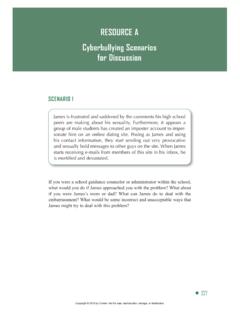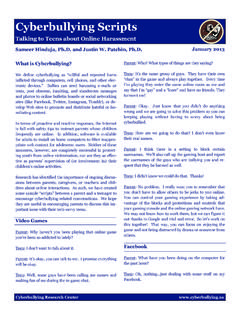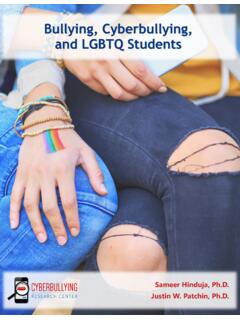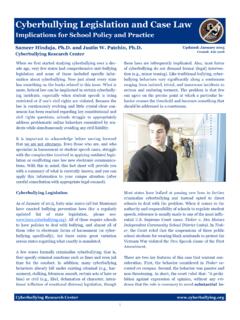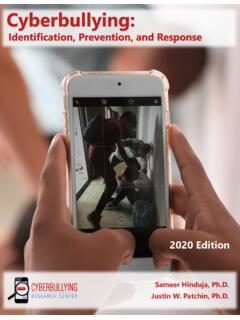Transcription of Cyberbullying Identification, Prevention, and Response
1 1 Cyberbullying : identification , prevention , & Response Sameer Hinduja, Justin W. Patchin, Cyberbullying Research Center October 2014 2 ids have been bullying each other for gener-ations. The latest generation, however, has been able to utilize technology to expand their reach and the extent of their harm. This phe-nomenon is being called Cyberbullying , defined as: willful and repeated harm inflicted through the use of computers, cell phones, and other electronic de-vices. Basically, we are referring to incidents where adolescents use technology to harass, threaten, hu-miliate, or otherwise hassle their peers. For exam-ple, youth can send hurtful text messages to others or spread rumors using smartphones or tablets. Teens have also created web pages, videos, and profiles on social media platforms making fun of others.
2 With mobile devices, adolescents have tak-en pictures in a bedroom, a bathroom, or another location where privacy is expected, and posted or distributed them online. Others have recorded un-authorized videos of other kids and uploaded them for the world to see, rate, tag, and discuss. Still oth-ers are embracing anonymous apps or chat func-tionality on gaming networks to tear down or hu-miliate others. What are some negative effects that cyber-bullying can have on a person? There are many detrimental outcomes associated with Cyberbullying that reach into the real world. First, many targets report feeling depressed, sad, angry, and frustrated. As one teenager stated: It makes me hurt both physically and mentally. It scares me and takes away all my confidence. It makes me feel sick and worthless.
3 Those who are victimized by Cyberbullying also reveal that they are often afraid or embarrassed to go to school. In ad-dition, research has revealed a link between cyber-bullying and low self-esteem, family problems, aca-demic difficulties, school violence, and various de-linquent behaviors. Finally, cyberbullied youth also report having suicidal thoughts, and there have been a number of examples in the United States and abroad where youth who were victimized end-ed up taking their own lives. Where does Cyberbullying commonly occur? Cyberbullying occurs across a variety of venues and mediums in cyberspace, and it shouldn t come as a surprise that it occurs most often where teenagers congregate. Initially, many kids hung out in chat rooms, and as a result that is where most harass-ment took place. In recent years, most youth are have been drawn to social media (such as Insta-gram, Snapchat, and Twitter) and video-sharing sites (such as YouTube).
4 This trend has led to in-creased reports of Cyberbullying occurring in those environments. Voice chat, textual chat, and texting via phones or tablets also can provide an environ-ment in which hate and harm is expressed. We are also seeing it happen with portable gaming devic-es, in 3-D virtual worlds and social gaming sites, and in newer interactive apps like Yik Yak, Secret, and Whisper. K 3 Cyberbullying by the numbers Estimates of the number of youth who experience Cyberbullying vary widely (ranging from 10-40% or more), depending on the age of the group studied and how Cyberbullying is formally defined. In our research, we inform students that Cyberbullying is when someone repeatedly makes fun of another person online or repeatedly picks on another per-son through email or text message or when some-one posts something online about another person that they don t like.
5 Using this definition, about 25 percent of the over 10,000 randomly-selected 11-18 year-olds we have surveyed over the last seven years have said that they have been cyberbullied at some point in their lifetimes. About 17 percent ad-mitted to Cyberbullying others during their lifetime. In our most recent study of middle-school youth from January of 2014, 12 percent said they had been cyberbullied while 4 percent said they had cyberbullied others within the previous 30 days. Cyberbullying vs. traditional bullying While often similar in terms of form and technique, Cyberbullying and bullying have many differences that can make the latter even more devastating. With the former, victims may not know who the bully is, or why they are being targeted. The cyber-bully can cloak his or her identity behind a comput-er or phone using anonymous email addresses or pseudonymous screen names.
6 Second, the hurtful actions of a cyberbully are viral; that is, a large number of people (at school, in the neighborhood, in the city, in the world!) can be involved the victim-ization, or at least find out about the incident with a few keystrokes or touchscreen impressions. It seems, then, that the pool of potential victims, of-fenders, and witnesses/bystanders is limitless. Third, it is often easier to be cruel using technology because Cyberbullying can be done from a physical-ly distant location, and the bully doesn t have to see the immediate Response by the target. In fact , some teens simply might not recognize the serious harm they are causing because they are sheltered from the victim s Response . Finally, while parents and teachers are doing a better job supervising youth at school and at home, many adults don t have the technological know -how (or time!)
7 To keep track of what teens are up to online. As a result, a victim s experiences may be missed and a bully s actions may be left unchecked. Even if bullies are identified, many adults find themselves unprepared to ade-quately respond. Why is Cyberbullying becoming a major issue? Cyberbullying is a growing problem because in-creasing numbers of kids are using and have com-pletely embraced online interactivity. A remarkable 95% of teens in the US are online, and three-fourths (74%) access the Internet on their mobile device. They do so for school work, to keep in touch with their friends, to play games, to learn about celebri-ties, to share their digital creations, or for many other reasons. Because the online communication 4 tools have become such a tremendous part of their lives, it is not surprising that some youth have de-cided to use the technology to be malicious or menacing towards others.
8 The fact that teens are connected to technology 24/7 means they are sus-ceptible to victimization (and able to act on mean intentions toward others) around the clock. As al-luded to, is also easier to be hateful using typed words rather than spoken words face-to-face. And because some adults have been slow to respond to Cyberbullying , many cyberbullies feel that there are little to no consequences for their actions. Many even feel that there is little chance of detection and identification , let alone sanction. Cyberbullying crosses all geographical boundaries. The Internet has really opened up the whole world to users who access it on a broad array of devices, and for the most part this has been a good thing (a really good thing!). Nevertheless, because of the issues previously discussed, some kids feel free to post or send whatever they want while online with-out considering how that content can inflict pain and sometimes cause severe psychological and emotional wounds.
9 Obstacles in the fight to stop Cyberbullying There are two primary challenges today that make it difficult to prevent Cyberbullying . First, even though this problem has been around for well over a decade, some people still don t see the harm as-sociated with it. Some attempt to dismiss or disre-gard Cyberbullying because there are more serious forms of aggression to worry about. While it is true that there are many issues facing adolescents, par-ents, teachers, and law enforcement today, we first need to accept that Cyberbullying is one such prob-lem that will only get more serious if ignored. The other challenge relates to who is willing to step up and take responsibility for responding to inap-propriate use of technology. Parents often say that they don t have the technical skills to keep up with their kids online behavior, and that schools should be covering it in detail during class time and through other programming.
10 Educators are often doing their part through policies, curricula, training, and assemblies, but sometimes don t know when and how to intervene in online behaviors that occur away from school but still involve their students. Finally, law enforcement is hesitant to get involved unless there is clear evidence of a crime or a signifi-cant threat to someone s physical safety. As a result, Cyberbullying incidents either slip through the cracks, are dealt with too formally, are dealt with too informally, or are otherwise mismanaged. At that point, the problem behaviors often continue and escalate because they aren t adequately or ap-propriately addressed. Based on these challenges, we collectively need to create an environment 5 where kids feel comfortable talking with adults about this problem and feel confident that mean-ingful steps will be taken to resolve the situation.
